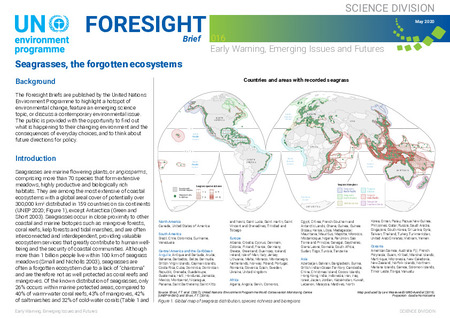| dc.contributor | Science Division | en_US |
| dc.contributor.author | United Nations Environment Programme | en_US |
| dc.coverage.spatial | Global | en_US |
| dc.date.accessioned | 2020-06-04T14:02:11Z | |
| dc.date.available | 2020-06-04T14:02:11Z | |
| dc.date.issued | 2020 | |
| dc.identifier.uri | https://wedocs.unep.org/20.500.11822/32643 | |
| dc.description | Seagrass meadows significantly support world fisheries production and global food security, providing valuable nursery habitat for over one fifth of the world’s largest fisheries (Unsworth et al. 2019), as well as shelter and food for thousands of species including threatened
charismatic species such as turtles, dugongs, seahorses and waterfowl. Recognizing the importance of seagrass ecosystems to biodiversity and human well-being (Figure 4) can help in conservation, better management and restoration of seagrass meadows. | en_US |
| dc.format | Text | en_US |
| dc.language | English | en_US |
| dc.language | French | |
| dc.relation.ispartof | Foresight Brief: Early Warning, Emerging Issues and Futures | en_US |
| dc.rights | Public | en_US |
| dc.subject | seagrass | en_US |
| dc.subject | marine ecosystem | en_US |
| dc.subject | nature conservation | en_US |
| dc.subject | food security | en_US |
| dc.title | Seagrasses, the Forgotten Ecosystems - Foresight Brief No. 016 May 2020 | en_US |
| dc.title.alternative | Herbiers marins : des écosystèmes oubliés - Note Perspective 016 | |
| wd.identifier.sdg | SDG 2 - No Hunger | en_US |
| wd.identifier.sdg | SDG 14 - Life Below Water | en_US |



